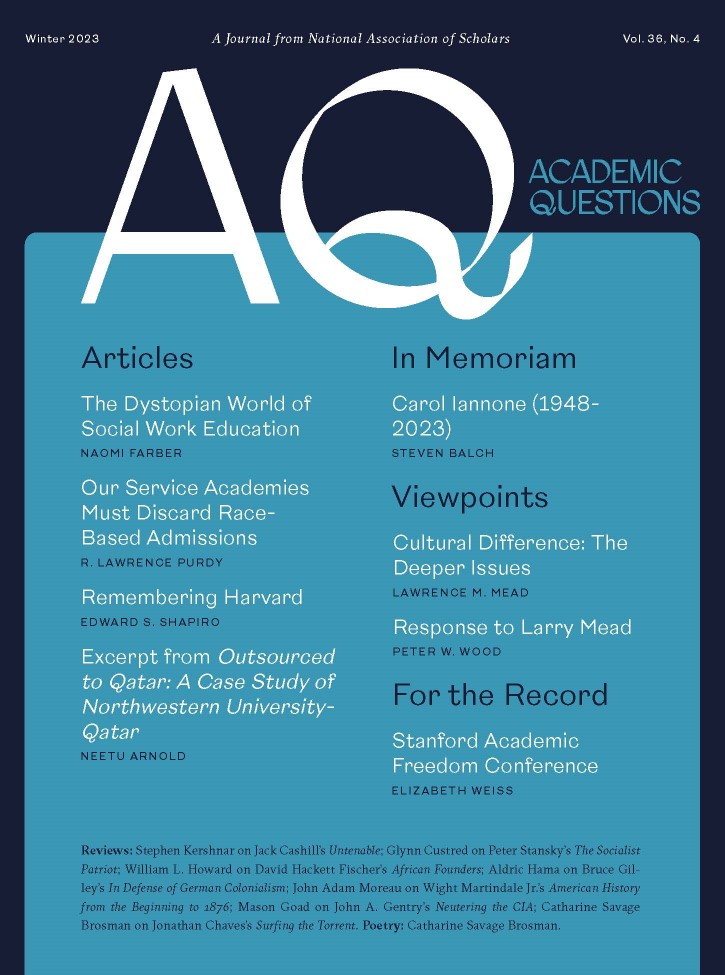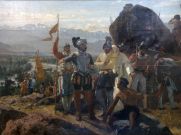“Culture” in the sense that Lawrence Mead uses it in his essay is a term derived from anthropology. It has roots in the German philosophical tradition associated with Johann Gottfried Herder (1744-1803). Herder emphasized that human communities are founded on shared language and a common spirit that cuts across all social divisions. In Herder’s view, nobles and peasants are equally part of the Völk, the folk, and join in a common allegiance to their land, their language, psychological dispositions, and character. Wrote Herder, “Every nation bears in itself the standard of its perfection, totally independent of all comparison with that of others.” He extended this observation to tribes and “savages.”
Herder had considerable influence over nineteenth century German thought but relatively little effect on the development of theories in France, Britain, and the U.S. The main lines of thought in those countries through the nineteenth century about what we now call cultural difference emphasized technology, social organization, and ideas. Some peoples had plows and draft animals; others had digging sticks; and still others lived on the hazards of what they could hunt or harvest from the wild. Some peoples had parliaments; some tribal chiefs; some just had extended families. Some peoples recognized a single deity; some worshipped a pantheon; some relied on magic spells.
These distinctions could be and were elaborated at great length by nineteenth century sociologists (Herbert Spencer, for example) and anthropologists (for example, Sir Edward Tylor and Lewis Henry Morgan), and proved to be a useful way to organize the ever-growing flood of ethnographic information that flowed in from around the world. The word “culture” appears in the writings of these figures as well, but with a key difference. It was used only in the singular. Humans possess “culture” everywhere, but some have more of it, and those who have more of it also have more sophisticated versions of it. Where Herder saw a multitude of Völk, each with its own distinctive “standard of perfection,” theorists such as Tylor and Morgan saw a single culture unevenly distributed across the globe. They also believed that all peoples were capable of “progress,” and could in time avail themselves of the opportunities to advance.
These nineteenth century social theorists (Spencer, Tylor, and Morgan are the best known, but there were many others) are today usually described (and dismissed) as “social evolutionists.” That term is misleading in a variety of ways, but mainly in its implications that these theorists focused on biological difference or that they viewed “society” as analogous to “species.” Rather, they concerned themselves mainly with progress. For them, social differences were rightly understood on a scale from simple to advanced—though they disagreed strongly on how to define that scale and what drove progress from one stage to another.
This unitary view of culture in the French and Anglophone traditions met its match in the 1880s when a German ethnologist, Franz Boas, began publishing his reports on the Eskimo in Greenland and the Indians on the northwest coast of America. Boas, steeped in the tradition inaugurated by Herder a century earlier, pluralized “culture,” and he built Herder’s conception of folk differences into a full-fledged theory that emphasized the utterly incommensurate differences among the world’s peoples. The older conception of a unitary “culture” lingered for a few decades as scholars trained in that tradition died off, but Boas’s novel pluralization swept through anthropology with hardly any opposition.
Boas himself trained many dozens of American anthropologists, including Margaret Mead, who evangelized the doctrine of cultural pluralism throughout the Anglophone world. When Mead speaks of “culture,” she is mainly drawing on this thread.
But this concept of culture has long since escaped the world of anthropology journals and ethnographic monographs. It has been absorbed in our mainstream social life as a handy way to point to sharp social discontinuities rooted between groups of people who have different customs, beliefs, and assumptions. And beyond this, it has become a tool for exaggerating those differences and even imagining “cultural” divisions out of thin air. The difference between East Coast and West Coast hip-hop musicians may matter to connoisseurs of rap, but they are not “cultural” unless that word is drained of any real meaning.
How well does Mead deploy it? When he sets it forth to distinguish his account of America’s most prominent internal differences from accounts that emphasize biological race, Mead is perfectly in line with the writings of Franz Boas, who a century ago wrote prolifically in opposition to the concept of race and how America understood race.
But there are, however, some troubles with this importation. Anthropologists themselves have long struggled with the amorphousness of the concept. Is every social difference a matter of culture? And is a culture a unified thing, in which the many parts reinforce the stable whole? Boas’s student, Ruth Benedict, wrote one of anthropology’s all-time best sellers in 1934, Patterns of Culture, in which she popularized the notion that each people has its own unique and deeply integrated culture: Pueblo culture, Kwakiutl culture, Dobuan culture, etc. These cultures cut from the spectrum of human possibility a segment of their own which they elaborate into a psychological, social, legal, and aesthetic whole. Each is a snowflake, seemingly impermeable to change—though not to collapse. Benedict famously cites the lament of a “Digger Indian” of southern California that God gave each people a clay cup of their own, but his people’s cup is now broken.
Few contemporary anthropologists uphold Benedict’s view of culture. The trouble is that “cultures” are seldom so stable. They change in myriad ways, adapting to changes in their physical environment, technological innovation, external threat, religious visions, missionaries, generational opportunities, and encounters with new ideas. Archaeology provides abundant evidence of tribes that might be mistaken as having been set in place from time immemorial as, instead, settled into a cultural niche for a few hundred years. “Horizons” measured by abrupt changes in pottery styles, burial practices, or other concrete indices demonstrate the fluidity of the human past. Populations that may indeed occupy land that their genetic ancestors held thousands of years ago may have only faint lines of cultural continuity with those ancestors.
The Benedictian view of culture as essentially static, or at a minimum, deeply conservative cannot account for all this fluidity. But Benedict did usefully capture two things. First, that the wholism she invokes is indeed a widespread characteristic of human communities: people do seem to conceive themselves more often than not as heirs to a great tradition that is worth preserving. The Kwakiutl of British Columbia in the 1880s did indeed see themselves as an eternal presence in their coastal precinct, and heirs of a perfectly complete order that encompassed nature, humanity, and the spirit world.
We can catch a glimpse of this in the recent news about another Northwest coast Indian tribe, the Niga’a, known in Boas’s day as the Nass River Tsimshian. In 1929 an unscrupulous Canadian anthropologist, Marius Barbeau, cut down a Niga’a totem pole and sold it to the Royal Scottish Museum in Edinburgh. Today’s Niga’a haven’t forgotten and just succeeded in getting the museum to return the totem pole.1 This is definitely not to say that Niga’a today possess intact the Niga’a “culture” of the 1920s, but they plainly possess a sense of Niga’a culture as something whole and valuable, regardless of whatever changes have transpired in the last hundred years. Cultural integration is perhaps best seen as an aesthetic ideal and political rallying point more than it is a cohesive reality.
But cohesiveness is not to be neglected. The desire to adjust all the parts of a social order to a sense of a harmonious whole is widespread in human groups, if not universal. Even if there is no real connection between the tribe’s dinner etiquette, its devotion to the gods, its facial tattooing, how it names its children, and how it arranges its furniture, there is strong chance that members of the tribe will feel that these things are importantly connected with one another, and that any family that is careless about one will be met with social disapproval and suspicion that it is also careless about the others.
The tribe may be in the grip of an illusion in thinking this way. After all, innovation will sneak in. But the idea that customs in different aspects of behavior are part of a single, meaningful pattern has psychological power everywhere.
These dimensions of culture play no explicit role in Lawrence Mead’s argument, but they are inevitably present below the surface. One cannot pick up the red-hot brand of “culture” without getting scorched. At the center of Mead’s essay is the idea that “the establishment refuses to discuss cultural difference.” At first reading, I respond with incredulity. These days we hear endlessly about cultural difference. If a white student at Bowdoin College puts a Mexican sombrero on his head to attend a taco party, he is promptly accused of “cultural appropriation.” Across the country, minority students admonish anyone not in their own exclusive cohort, “My culture is not your costume.” Cultural “sensitivity” is the edict propounded from every source of cultural authority, in mass media, politics, religion, sports, and the arts.
What in the world can Mead mean by saying “the establishment refuses to discuss cultural difference?” What he means, he soon makes clear, is that “the establishment” is blind to a particular dimension of cultural difference, which I will paraphrase as self-assertive individualism. Immigrants coming from cultural backgrounds outside the West, he asserts, “respond more strongly to authority than incentives.” This makes them ill-suited to thrive in the institutional contexts of American society: school, employment, law, and the family as configured by our bourgeois order. “The essence of mainstream culture is that the forces of authority have migrated from outside to inside the self.”
Mead is far from alone in noticing the salience of the autonomous self in the contemporary West and its apotheosis in contemporary America. The decline of Biblical religion in America is one conspicuous reason for this elevation of the self over external authority. We have quite a few social theorists, ranging from Charles Taylor (Sources of the Self) to Christopher Lasch (The Culture of Narcissism; The Minimal Self) who spent their careers dissecting the tectonic shifts in the locus of authority, and the matter remains front and center in current debates among conservatives over how to account for the decline in virtue and trust among Americans (Patrick Deneen, Joshua Mitchell, Sohrab Ahmari).
In view of the prominence of this debate over the locus of authority and the centrality of the “self” one might think that Mead’s thesis would have easily been taken up for debate, but his essay complains that his book Burdens of Freedom was largely ignored. He recognizes that much of the reason for that is that he has taken an unfashionable stand on immigration from the Third World. The currently approved line of thought on many millions of new immigrants from Latin America, Africa, the Middle East, India, and Asia is that these groups will soon, or at least eventually, assimilate to American values.
Mead counters with the thesis that immigrants from these parts of the globe generally do not carry with them the predicates of “personal agency” that will enable them to adopt American individualism any time soon. Rather they carry in their backpacks the assumptions of loyalty to their families and ethnic groups. Investment in universal principles of order is not part of the cultural equipment. Their “weaker sense of agency” makes them poor recruits for a social order based on freedom and personal responsibility.
It is not hard to see why this analysis is unpalatable in a nation that persists in regarding itself as generous, enlightened, and humane. We would prefer to see people from around the world who elect to come to America as sharing our high regard for individual striving. After all, their presence in the United States is itself evidence of considerable striving. But putting that aside, does Mead’s argument carry weight? Is the main cultural difference between the West and the rest a matter of our individualism versus their default communalism? Are the huddled masses yearning to breathe free but mostly to find more space for additional tax-supported huddling? Is their capacity for higher social order limited to people who speak the same dialects or who learn the levers of identitarian politics? Is the passivity of underprivileged groups in America their own damned fault?
I share much of Mead’s apprehensions about our failure to control our borders and our nonchalance about assimilating immigrants, as though they will gladly do that by themselves. But I think Mead puts his argument in jeopardy by overgeneralizing. “Culture” is not one thing. Rather it is a broad and dramatically uneven collection of premises arising from a multitude of different experiences. Some immigrant groups come brilliantly equipped to assimilate to American individualism. They come from cultural backgrounds that in some cases far excel most contemporary Americans in their emphasis on personal striving, self-sufficiency, moral responsibility, and respect for the opportunities at hand. Others, however, come from risk-averse cultures in which there is no shame in dependency and little expectation of social advancement.
We would be wise as a nation to recognize these kinds of cultural differences among immigrant groups. The people seeking to come here do not all come for the same reasons, (though they quickly learn to parrot whatever reasons the American authorities want to hear). There is no crisp divide between “Western culture” and the collectivist non-West.
Western culture, itself a kaleidoscopic mixture of many societies with their own cultural patterns, does have some very deep commonalities to draw on, but those are not reducible to the entrepreneurial and morally autonomous individual. He is “in there,” as Don Quixote and Wild Bill Hickok are in there, but so are medieval monasteries, Brooke Farm, and Burning Man. Things are complicated. The non-West is full of its own complexities, and not to be summarized as a supra-culture of collective indolence.
Mead, I regret, borrowed too freely from the anthropological tradition. “Cultural differences” are indeed important, but they are more confounding than he seems to realize.
Peter Wood is the Editor in Chief of Academic Questions and President of the National Association of Scholars. Before he was appointed president of the NAS in January 2009 he served as NAS’s executive director (2007-2008), and as provost of The King’s College in New York City (2005-2007). Wood was a tenured member of the Anthropology Department at Boston University, where he also held a variety of administrative positions, including associate provost and president’s chief of staff. He also oversaw the university’s scholarly publications and served as acting university librarian. Wood has been published widely and is the author of several critically acclaimed books.
1 Emma Bubola, “Totem Pole Taken 94 Years Ago begins 4,000-Mile Journey Home,” The New York Times, August 29, 2023.
Photo by JackF on Adobe Stock














